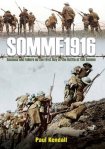Success and Failure on the First Day of the Battle of the Somme
By Paul Kendall
Frontline Books, 2015
 In this work Paul Kendall brings together an overarching examination of operations on 1st July 1916 along the whole of the British front. The first part of the book (entitled ‘Prelude’) briefly examines the British Army of 1914-15 before looking at the planning and preparations for the Somme offensive. Kendall highlights that the Germans had had plenty of time to prepare strong defensive positions, and that the British preparations required in terms of infrastructure (roads, railways, billets, sanitation, communication etc), meant that the Germans were aware of the influx of troops to the area and even considered a pre-emptive strike.
In this work Paul Kendall brings together an overarching examination of operations on 1st July 1916 along the whole of the British front. The first part of the book (entitled ‘Prelude’) briefly examines the British Army of 1914-15 before looking at the planning and preparations for the Somme offensive. Kendall highlights that the Germans had had plenty of time to prepare strong defensive positions, and that the British preparations required in terms of infrastructure (roads, railways, billets, sanitation, communication etc), meant that the Germans were aware of the influx of troops to the area and even considered a pre-emptive strike.
Details of the practicalities of the artillery bombardment are given; with three times as many artillery pieces in action than there had been before Loos, it is perhaps easy to see how the British believed the German defences would be obliterated. However, intelligence reports showed large swathes of barbed wire remained uncut, yet these reports were not acted upon, although Haig remained optimistic of success.
Part 2 forms the bulk of the book, detailing the action on 1st July corps by corps from north to south. Chapters are split into divisions, with an introduction giving details of the command structure and the corps objectives. A narrative incorporating personal accounts then details the action down to battalion level. Each chapter contains a map to show the area of operation for each corps, however more detailed maps to support the narrative would have been beneficial.
Kendall’s narrative of the Gommecourt diversion (VII Corps) makes you wonder if it ever stood any chance of success against the formidable German defences. A picture of chaotic failure is painted, one that led to Major General Stuart-Wortley (46th Division) being relieved of duty. As the action moves south through Serre, the Redan ridge, Beaumont Hamel and Thiepval, the failure of the artillery to smash the German defences and batteries meant that many men were met by withering machine gun fire and German artillery bombardment. Where small pockets of men were successful, they were overwhelmed before any gains could be exploited. The only real successes of the day were at the south of the line around Montauban, largely helped by weaker German defences and French artillery support.
The final part of the book focuses on the aftermath and an assessment of the day’s action. Kendall highlights the difficulty of getting accurate communications, the lack of consolidation where there had been success, and the fact that the scale of losses was not immediately fully realised. The successes were naturally overshadowed by the casualties and lack of gains along much of the line. Kendall attributes the failure to the over-reliance on artillery, and the inflexibility of the artillery barrages that the troops were required to keep pace with. Although Kendall asserts that the battle could not really be evaluated until after the war had ended, I was surprised to see little mention of the impact the campaign had on the development of strategy and tactics (the so-called learning curve).
A quick glance at the bibliography shows that a variety of sources from The National Archives, Imperial War Museum, newspapers, private papers, and audio recordings have been consulted. A selection of pictures include ‘then and now’ views as well as some of the ‘usual suspects’ that can be found in many books about the battle. Comprehensive footnotes highlight the breadth of resources consulted, and an index of places, units, and people will prove invaluable for those looking to dip in to specific areas.
Does the book offer anything new? Ardent students of the Somme will no doubt be familiar with the success and failures along the length of the British front, and the reasons for these. However, Paul Kendall has done a good job of bringing a diverse array of sources and accounts together to create a cohesive narrative of the day’s events that is equally as useful as a reference work.
Buy this book from Amazon here:
Somme 1916 by (Historian) Paul Kendall (November 30, 2015) Hardcover
